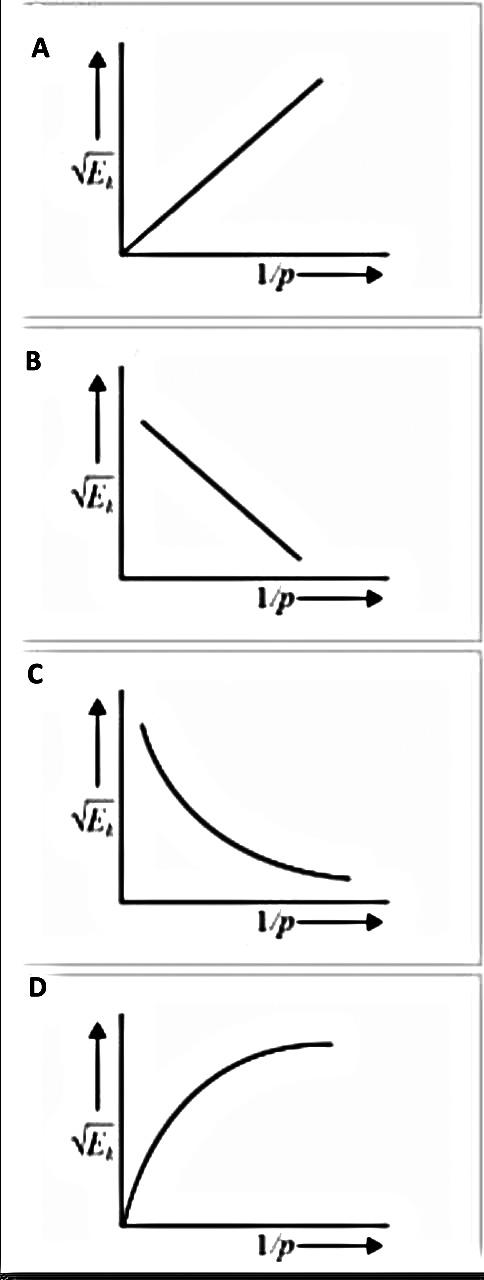
The relationship between $\sqrt {{E_k}} $ versus $\dfrac{1}{p}$ is,


Answer
558.6k+ views
Hint
Use the formula of kinetic energy ${E_k} = \dfrac{1}{2}m{v^2}$ and convert the RHS in terms of momentum and then eliminate option to reach the answer or find out the correct answer by squaring and comparing it with the standard equation of parabola ${y^2} = 4ax$
Complete step by step answer
We know that kinetic energy is given by the formula
${E_k} = \dfrac{1}{2}m{v^2}$
Now multiplying both the numerator and denominator with m we get,
$ \Rightarrow {E_k} = \dfrac{{{{(mv)}^2}}}{{2m}}$
Now we know that the momentum of a body or system is given by $p = mv$and hence putting this value in the above expression of kinetic energy we have,
$ \Rightarrow {E_k} = \dfrac{{{{(p)}^2}}}{{2m}}$
From the above relation it is clear that the kinetic energy is proportional to the square of momentum.
Since it is proportional to the square of momentum therefore the options A and B are thus disposed of.
OR,
$ \Rightarrow \sqrt {{E_k}} \,\,\alpha \,\,p$
Putting the value of momentum as zero, the kinetic energy is also zero. Therefore the graph must satisfy the points $(0,0)$.
Out of the given options only option (D) is satisfying the given condition and hence the correct answer is option (D).
Note
Alternatively one may know the graph (C) as a rectangular hyperbola and may eliminate it directly as well since rectangular hyperbola has the relation $y = \dfrac{1}{x}$ in this particular case.
Alternatively one may square both the sides and compare option D with the standard equation of parabola to find out the answer directly after eliminating both option A and B.
Use the formula of kinetic energy ${E_k} = \dfrac{1}{2}m{v^2}$ and convert the RHS in terms of momentum and then eliminate option to reach the answer or find out the correct answer by squaring and comparing it with the standard equation of parabola ${y^2} = 4ax$
Complete step by step answer
We know that kinetic energy is given by the formula
${E_k} = \dfrac{1}{2}m{v^2}$
Now multiplying both the numerator and denominator with m we get,
$ \Rightarrow {E_k} = \dfrac{{{{(mv)}^2}}}{{2m}}$
Now we know that the momentum of a body or system is given by $p = mv$and hence putting this value in the above expression of kinetic energy we have,
$ \Rightarrow {E_k} = \dfrac{{{{(p)}^2}}}{{2m}}$
From the above relation it is clear that the kinetic energy is proportional to the square of momentum.
Since it is proportional to the square of momentum therefore the options A and B are thus disposed of.
OR,
$ \Rightarrow \sqrt {{E_k}} \,\,\alpha \,\,p$
Putting the value of momentum as zero, the kinetic energy is also zero. Therefore the graph must satisfy the points $(0,0)$.
Out of the given options only option (D) is satisfying the given condition and hence the correct answer is option (D).
Note
Alternatively one may know the graph (C) as a rectangular hyperbola and may eliminate it directly as well since rectangular hyperbola has the relation $y = \dfrac{1}{x}$ in this particular case.
Alternatively one may square both the sides and compare option D with the standard equation of parabola to find out the answer directly after eliminating both option A and B.
Recently Updated Pages
Why are manures considered better than fertilizers class 11 biology CBSE

Find the coordinates of the midpoint of the line segment class 11 maths CBSE

Distinguish between static friction limiting friction class 11 physics CBSE

The Chairman of the constituent Assembly was A Jawaharlal class 11 social science CBSE

The first National Commission on Labour NCL submitted class 11 social science CBSE

Number of all subshell of n + l 7 is A 4 B 5 C 6 D class 11 chemistry CBSE

Trending doubts
What is meant by exothermic and endothermic reactions class 11 chemistry CBSE

10 examples of friction in our daily life

One Metric ton is equal to kg A 10000 B 1000 C 100 class 11 physics CBSE

1 Quintal is equal to a 110 kg b 10 kg c 100kg d 1000 class 11 physics CBSE

Difference Between Prokaryotic Cells and Eukaryotic Cells

What are Quantum numbers Explain the quantum number class 11 chemistry CBSE




